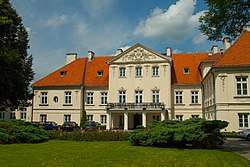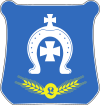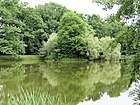Leszno, Warsaw West County
Leszno [ˈlɛʂnɔ] is a village in Warsaw West County, Masovian Voivodeship, in east-central Poland. It is the seat of the gmina (administrative district) called Gmina Leszno.[1] It lies approximately 15 kilometres (9 mi) west of Ożarów Mazowiecki and 28 km (17 mi) west of Warsaw.
Leszno | |
|---|---|
Village | |
 Łuszczewski Palace in Leszno | |
 Coat of arms | |
 Leszno | |
| Coordinates: 52°16′N 20°36′E | |
| Country | |
| Voivodeship | Masovian |
| County | Warsaw West |
| Gmina | Leszno |
| Population | 3,500 |
| Time zone | UTC+1 (CET) |
| • Summer (DST) | UTC+2 (CEST) |
| Website | http://www.gminaleszno.pl/ |
The village has a population of 3,500.
Polish professional footballer Robert Lewandowski grew up in Leszno.[2] In 2016 he became an honorary citizen of Leszno.[2]
History
The history of Leszno dates back to the Middle Ages. It was mentioned in documents in 1423.[3] It was owned by various families, including the Łuszczewski family, which built a Baroque palace, which is the main landmark of the village.[3]
During the invasion of Poland, which started World War II, in early September 1939, the Germans captured Leszno.[4] On September 16, Poles recaptured the village for tactical purposes, while the Germans retreated in panic.[4] On September 17, the Germans occupied Leszno again, and carried out a massacre of around 50 inhabitants in an act of revenge.[5] Many men were transported to Błonie, from where they were to be deported to forced labor to Germany, but some managed to escape.[4] About 70% of the village was burned down.[4]
Sights
The main landmark of Leszno is the Baroque Łuszczewski Palace with an adjacent park. There are two historic churches, one Catholic and one Mariavite. In the village there is also a monument commemorating Polish soldiers, partisans and inhabitants killed during World War II.[3]
Gallery
 Architectural decorations on the facade of the Łuszczewski Palace
Architectural decorations on the facade of the Łuszczewski Palace Park
Park Saint John the Baptist church
Saint John the Baptist church Gmina office
Gmina office
References
- "Central Statistical Office (GUS) - TERYT (National Register of Territorial Land Apportionment Journal)" (in Polish). 2008-06-01.
- "Robert Lewandowski honorowym obywatelem Leszna". ZachodnieMazowsze.info (in Polish). Retrieved 8 May 2020.
- "Wieś Leszno". Szlaki turystyczne Mazowsza (in Polish). Retrieved 8 May 2020.
- "79. rocznica spalenia Leszna". Stowarzyszenie Aktywne Leszno (in Polish). Retrieved 8 May 2020.
- Maria Wardzyńska, Był rok 1939. Operacja niemieckiej policji bezpieczeństwa w Polsce. Intelligenzaktion, IPN, Warszawa, 2009, p. 97 (in Polish)